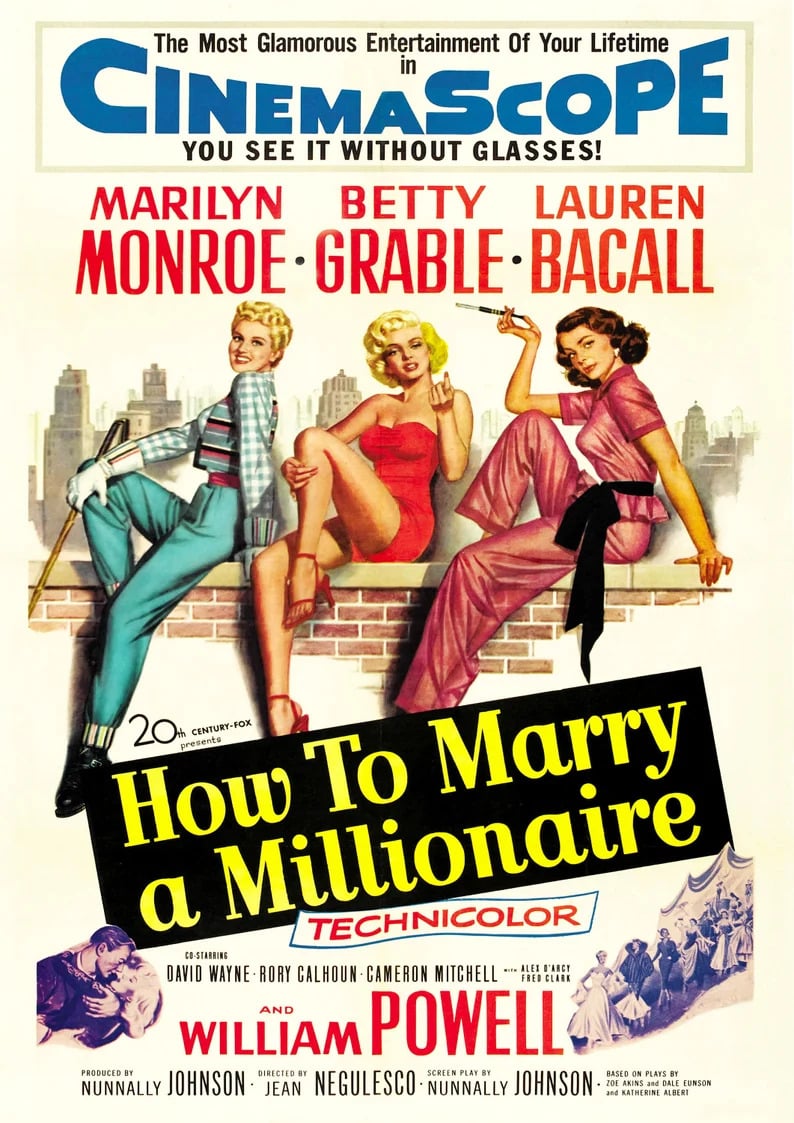
- Starring
- Betty Grable, Marilyn Monroe, Lauren Bacall
- Writer
- Nunnally Johnson
- Director
- Jean Negulesco
- Rating
- G (Canada)
- Running Time
- 95 minutes
Overall Score
Rating Summary
How to Marry a Millionaire will always be overshadowed by Gentlemen Prefer Blondes which was released the same year. Both films focus on the emotional bonds that exist between amoral gold diggers and the constantly shifting sexual mores of the era. The latter was a brash, ostentatious musical that displayed considerable chutzpah and wit in choosing to satirize the gender politics of the era whilst still finding a way to highlight Marilyn Monroe’s pulchritude. It served as a significant influence on future sex comedies and celebrated eroticism in a surprisingly gleeful, joyous manner. On a superficial level, this film possesses many of the attributes that allowed the latter to become an indelible classic but it consistently fails to live up to expectations.
The premise isn’t particularly imaginative, as it serves as a fairly flimsy excuse to unite three legendary sex symbols. How to Marry a Millionaire sees Bacall takes center stage as Schatze Page, an ageing model who aims to repress her desire for authority in order to make herself more appealing to the wealthy J.D. Hanley (William Powell). She ends up moving in with the daffy Pola Debevoise (Monroe) and the mimsy-mumsy Loco Dempsey (Grable), who share her ambitions. All three of them end up falling for men who appear to have poor financial prospects. They decide to value love over money and are very pleased to learn that one of their husbands is actually a multi-millionaire.
This is one of those blockbusters that never really comes to life. Viewers can see why the prospect of seeing Bacall and Monroe go toe-to-toe seemed tantalizing to audience-goers, but the screenplay is so painfully generic that it fails to exploit the differences between their star personas. The film’s protagonists have such vaguely defined personalities that they could have been played by any toothsome starlet from this era. Even though the film ostensibly serves as a star vehicle, it doesn’t understand what endeared these actresses to audience members. Fans of Bacall were attracted to her insolence and precocity. There was also something highly seductive about her apparent lack of desire to make accommodations for her on-screen love interests. Page is presented as a middle-aged fusspot who spends a great deal of time fretting over trivial matters and Bacall’s acid wit is frequently neutralized in scenes that should have been injected with a little more bite. A more sophisticated sexploitation flick might have integrated sly commentary on gender roles into its treatment of these wildly different performers. Sadly, Katherine Albert fails to say anything insightful about the clash between the values of the 1940s and the 1950s.
Director Jean Negulesco also drops the ball when it comes to putting the then-revolutionary CinemaScope technology to effective use. He primarily employs the expanded scale of the lens to fit three actresses into the frame and stages them in an oddly theatrical manner that ensures that the visuals look flat. Other visual extravaganzas of the period could be accused of looking garish or tacky but How to Marry a Millionaire needed to feature more flash and razzle dazzle. Negulesco has a whole lot money on his hands but he never finds the time to luxuriate in all of the superficial beauty that can be found in almost every frame. The audience is always kept at arm’s length, unable to wholeheartedly admire the perfectly tailored gowns and well-appointed New York apartments. For any going into this looking for lifestyle pornography, they will be sorely disappointed.
Monroe manages to nonetheless turn on the charm in a couple of throwaway sequences and makes the most out of a recurring gag involving her character’s refusal to wear bifocals. It should also be noted that the film is still an easy, breezy piece of entertainment that doesn’t demand that audience members apply their critical thinking skills to their analysis of the picture’s themes. This is another example of the sort of inconsequential fluff that people fallaciously accuse Monroe of having peddled throughout her entire career.
Discerning film-goers will find more value in the sharp, anti-capitalist comedies that helped to bolster her critical reputation but How to Marry a Millionaire can still claim to have served as an important stepping stone in the careers of several noted thespians. For those wanting to watch ninety or so minutes of gorgeous gals swanning around in the hottest fashions of 1953, this will satisfy your cravings.
still courtesy of 20th Century Studios
If you liked this, please read our other reviews here and don’t forget to follow us on Twitter or Instagram or like us on Facebook.

I am passionate about screwball comedies from the 1930s and certain actresses from the Golden Age of Hollywood. I’ll aim to review new Netflix releases and write features, so expect a lot of romantic comedies and cult favourites.

